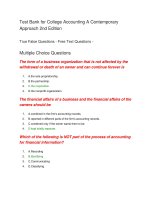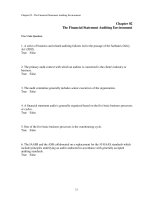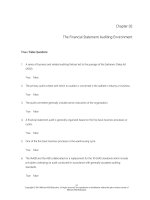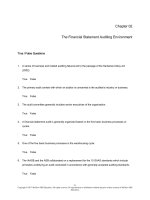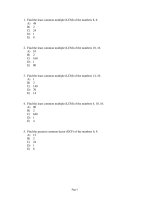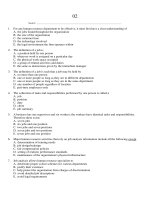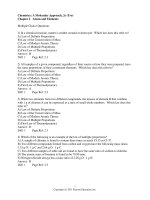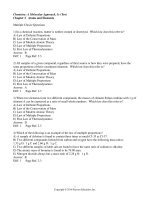College accounting a career approach 12th edition scott test bank
Bạn đang xem bản rút gọn của tài liệu. Xem và tải ngay bản đầy đủ của tài liệu tại đây (337.16 KB, 24 trang )
Chapter 2—T Accounts, Debits and Credits, Trial Balance, and Financial Statements
MULTIPLE CHOICE
1. The normal balance of an account is on the
a. plus side.
b. left side.
c. debit side.
d. right side.
e. credit side.
ANS:
OBJ:
STA:
KEY:
A
PTS: 1
DIF: Difficulty: Easy
LO: 2-1
NAT: AACSB: Reflective Thinking
AICPA-FN: Measurement|ACBSP: Recording Transactions
Bloom's: Knowledge
2. When a T account has several items on both sides, the balance of the account is written
a. on the side with the greatest number of items.
b. on the side with the least number of items.
c. on the side with the larger total.
d. on the side with the smaller total.
e. in none of these locations.
ANS:
OBJ:
STA:
KEY:
C
PTS: 1
DIF: Difficulty: Moderate
LO: 2-1
NAT: AACSB: Reflective Thinking
AICPA-FN: Measurement|ACBSP: Recording Transactions
Bloom's: Comprehension
3. A debit may signify a decrease in a(n)
a. liability account.
b. asset account.
c. revenue account.
d. liability and a revenue account.
e. asset and a revenue account.
ANS:
OBJ:
STA:
KEY:
D
PTS: 1
DIF: Difficulty: Moderate
LO: 2-3
NAT: AACSB: Reflective Thinking
AICPA-FN: Measurement|ACBSP: Recording Transactions
Bloom's: Comprehension
4. A debit may result in
a. an increase in an expense account.
b. an increase in an asset account.
c. a decrease in a liability account.
d. a decrease in a revenue account.
e. all of these.
ANS:
OBJ:
STA:
KEY:
E
PTS: 1
DIF: Difficulty: Moderate
LO: 2-3
NAT: AACSB: Reflective Thinking
AICPA-FN: Measurement|ACBSP: Recording Transactions
Bloom's: Comprehension
5. A credit may result in
a. an increase in a liability account.
© 2015 Cengage Learning. All Rights Reserved. May not be scanned, copied or duplicated, or posted to a publicly
accessible website, in whole or in part.
b.
c.
d.
e.
an increase in a revenue account.
a decrease in an asset account.
an increase in the Capital account.
all of these.
ANS:
OBJ:
STA:
KEY:
E
PTS: 1
DIF: Difficulty: Moderate
LO: 2-3
NAT: AACSB: Reflective Thinking
AICPA-FN: Measurement|ACBSP: Recording Transactions
Bloom's: Comprehension
6. A credit may result in
a. an increase in an asset account.
b. a decrease in the Capital account.
c. an increase in a liability account.
d. a decrease in a liability account.
e. none of these.
ANS:
OBJ:
STA:
KEY:
C
PTS: 1
DIF: Difficulty: Moderate
LO: 2-3
NAT: AACSB: Reflective Thinking
AICPA-FN: Measurement|ACBSP: Recording Transactions
Bloom's: Comprehension
7. Which of the following classifications of accounts has/have a normal credit balance?
a. Drawing
b. Revenues
c. Liabilities
d. Revenues and liabilities
e. All of these
ANS:
OBJ:
STA:
KEY:
D
PTS: 1
DIF: Difficulty: Easy
LO: 2-1 | LO: 2-3
NAT: AACSB: Reflective Thinking
AICPA-FN: Measurement|ACBSP: Recording Transactions
Bloom's: Comprehension
8. Which of the following describes the classification and normal balance of H. Gale, Capital?
a. Asset, debit
b. Revenue, credit
c. Owner's equity, debit
d. Expense, debit
e. None of these
ANS: E
PTS: 1
DIF: Difficulty: Easy
OBJ: LO: 2-1 | LO: 2-3
NAT: AACSB: Reflective Thinking
STA: AICPA-FN: Measurement|ACBSP: GAAP
KEY: Bloom's: Knowledge
9. Which of the following describes the classification and normal balance of the Income from Services
account?
a. Capital, debit
b. Revenue, credit
c. Asset, credit
d. Asset, debit
e. Expense, debit
ANS: B
PTS: 1
OBJ: LO: 2-1 | LO: 2-3
DIF: Difficulty: Easy
NAT: AACSB: Reflective Thinking
© 2015 Cengage Learning. All Rights Reserved. May not be scanned, copied or duplicated, or posted to a publicly
accessible website, in whole or in part.
STA: AICPA-FN: Measurement|ACBSP: GAAP
KEY: Bloom's: Knowledge
10. Which of the following is an asset account?
a. Insurance Expense
b. Advertising Expense
c. Office Equipment
d. Sales
e. None of these
ANS: C
PTS: 1
DIF: Difficulty: Easy
OBJ: LO: 2-4
NAT: AACSB: Reflective Thinking
STA: AICPA-FN: Measurement|ACBSP: GAAP
KEY: Bloom's: Knowledge
11. The second step in the analytical phase of accounting is
a. to determine whether there is an increase or a decrease in the accounts.
b. to determine which accounts are involved.
c. to formulate the entry as a debit to one account and as a credit to another account.
d. to identify the classification of the accounts involved.
e. none of these.
ANS:
OBJ:
STA:
KEY:
D
PTS: 1
DIF: Difficulty: Moderate
LO: 2-4
NAT: AACSB: Reflective Thinking
AICPA-FN: Measurement|ACBSP: Recording Transactions
Bloom's: Comprehension
12. If a $47 cash purchase of supplies is recorded as a $57 debit to Supplies Expense and a $57 credit to
Cash, the result will be that
a. the trial balance will be out of balance.
b. the Supplies Expense account will be understated.
c. the Cash account will be overstated.
d. Supplies Expense will be overstated and Supplies will be understated.
e. none of these will be true.
ANS:
OBJ:
STA:
KEY:
D
PTS: 1
DIF: Difficulty: Moderate
LO: 2-4
NAT: AACSB: Analytic
AICPA-FN: Measurement|ACBSP: Recording Transactions
Bloom's: Application
13. A purchase of supplies on account should be recorded as
a. a debit to Supplies and a credit to Cash.
b. a debit to Accounts Payable and a credit to Supplies.
c. a debit to Supplies and a credit to Accounts Payable.
d. a debit to Supplies Expense and a credit to Accounts Receivable.
e. none of these.
ANS:
OBJ:
STA:
KEY:
C
PTS: 1
DIF: Difficulty: Moderate
LO: 2-4
NAT: AACSB: Analytic
AICPA-FN: Measurement|ACBSP: Recording Transactions
Bloom's: Application
14. A business buys office equipment for cash. What effect will this transaction have on the accounts?
a. Debit an asset account and credit an expense account
b. Debit an asset account and credit an asset account
c. Debit an expense account and credit an asset account
d. Debit a liability account and credit an asset account
© 2015 Cengage Learning. All Rights Reserved. May not be scanned, copied or duplicated, or posted to a publicly
accessible website, in whole or in part.
e. None of these
ANS:
OBJ:
STA:
KEY:
B
PTS: 1
DIF: Difficulty: Moderate
LO: 2-4
NAT: AACSB: Analytic
AICPA-FN: Measurement|ACBSP: Recording Transactions
Bloom's: Application
15. The receipt of cash on account from a customer should be recorded as
a. a debit to Cash and a credit to Accounts Payable.
b. a debit to Cash and a credit to Income from Services.
c. a debit to Cash and a credit to Accounts Receivable.
d. a debit to Cash and a credit to the Capital account.
e. none of these.
ANS:
OBJ:
STA:
KEY:
C
PTS: 1
DIF: Difficulty: Moderate
LO: 2-4
NAT: AACSB: Analytic
AICPA-FN: Measurement|ACBSP: Recording Transactions
Bloom's: Application
16. The asset that a business enterprise creates when it maintains accounts for its charge customers is
a. Accounts Payable.
b. Drawing.
c. Accounts Receivable.
d. Capital.
e. none of these.
ANS: C
PTS: 1
DIF: Difficulty: Easy
OBJ: LO: 2-4
NAT: AACSB: Reflective Thinking
STA: AICPA-FN: Measurement|ACBSP: GAAP
KEY: Bloom's: Comprehension
17. Which of the following entries records the withdrawal of cash for personal use by D. Bill, the owner of a
business?
a. Debit Cash and credit D. Bill, Drawing
b. Debit Cash and credit Salary Expense
c. Debit Salary Expense and credit Cash
d. Debit D. Bill, Drawing and credit Cash
e. None of these
ANS:
OBJ:
STA:
KEY:
D
PTS: 1
DIF: Difficulty: Moderate
LO: 2-4
NAT: AACSB: Analytic
AICPA-FN: Measurement|ACBSP: Recording Transactions
Bloom's: Application
18. A trial balance is
a. a listing of all the assets, liabilities, and owner's equity accounts that have balances.
b. a listing of all the accounts that have zero balances.
c. a listing of all the revenue and expense accounts that have balances.
d. all of these.
e. none of these.
ANS:
OBJ:
STA:
KEY:
A
PTS: 1
DIF: Difficulty: Easy
LO: 2-5
NAT: AACSB: Reflective Thinking
AICPA-FN: Measurement|ACBSP: Recording Transactions
Bloom's: Knowledge
© 2015 Cengage Learning. All Rights Reserved. May not be scanned, copied or duplicated, or posted to a publicly
accessible website, in whole or in part.
19. To locate an error in a trial balance,
a. re-add.
b. look for the correct location of normal balances.
c. verify figures transferred from the account to the trial balance.
d. check footings and balances of the accounts.
e. do all of these.
ANS:
OBJ:
STA:
KEY:
E
PTS: 1
DIF: Difficulty: Moderate
LO: 2-5
NAT: AACSB: Reflective Thinking
AICPA-FN: Measurement|ACBSP: Recording Transactions
Bloom's: Comprehension
20. The trial balance will not expose which of the following problems?
a. Recording half an entry
b. Leaving out an entire entry
c. Recording both halves of an entry on the same side
d. Recording half an entry and leaving out an entire entry
e. Recording half an entry and recording both halves of an entry on the same side
ANS:
OBJ:
STA:
KEY:
B
PTS: 1
DIF: Difficulty: Challenging
LO: 2-5
NAT: AACSB: Reflective Thinking
AICPA-FN: Measurement|ACBSP: Recording Transactions
Bloom's: Comprehension
21. The Accounts Receivable T account shows the following
$250, debit
$1,250, debit
$300, credit
$250, credit
What is the balance of the account?
a. $1,500, debit
b. $550, credit
c. $950, debit
d. $950, credit
e. $2,050, debit
ANS:
OBJ:
STA:
KEY:
C
PTS: 1
DIF: Difficulty: Moderate
LO: 2-1
NAT: AACSB: Analytic
AICPA-FN: Measurement|ACBSP: Recording Transactions
Bloom's: Application
22. The Accounts Payable T account shows the following
$1,200, debit
$3,500, debit
$8,240, credit
$100, credit
What is the balance of the account?
a. $8,340, credit
b. $8,340, debit
c. $4,700, debit
d. $3,640, debit
© 2015 Cengage Learning. All Rights Reserved. May not be scanned, copied or duplicated, or posted to a publicly
accessible website, in whole or in part.
e. $3,640, credit
ANS:
OBJ:
STA:
KEY:
E
PTS: 1
DIF: Difficulty: Moderate
LO: 2-1
NAT: AACSB: Analytic
AICPA-FN: Measurement|ACBSP: Recording Transactions
Bloom's: Application
23. The ___________ are the totals of each side of a T account that is normally recorded in small,
pencil-written figures.
a. balances
b. footings
c. figures
d. estimates
ANS:
OBJ:
STA:
KEY:
B
PTS: 1
DIF: Difficulty: Easy
LO: 2-1
NAT: AACSB: Reflective Thinking
AICPA-FN: Measurement|ACBSP: Recording Transactions
Bloom's: Knowledge
24. Which of the following is correct concerning a T account?
a. The left side is the decrease side for assets.
b. The right side is the decrease side for liabilities.
c. The right side is the increase side for revenue.
d. The left side is the decrease side for expenses.
ANS:
OBJ:
STA:
KEY:
C
PTS: 1
DIF: Difficulty: Moderate
LO: 2-2
NAT: AACSB: Reflective Thinking
AICPA-FN: Measurement|ACBSP: Recording Transactions
Bloom's: Comprehension
25. Which of the following is not true concerning T accounts?
a. The right side of a revenue account is an increase.
b. The left side of an expense account is an increase.
c. The left side of an asset account is an increase.
d. The left side of a liability account is an increase.
ANS:
OBJ:
STA:
KEY:
D
PTS: 1
DIF: Difficulty: Moderate
LO: 2-2
NAT: AACSB: Reflective Thinking
AICPA-FN: Measurement|ACBSP: Recording Transactions
Bloom's: Comprehension
26. Which of the following is correct?
a. Debit is the normal balance of the accounts payable account.
b. Credit is the normal balance of the accounts receivable account.
c. Debit is the normal balance of the Income from Services account.
d. Debit is the normal balance of the Drawing account.
ANS:
OBJ:
STA:
KEY:
D
PTS: 1
DIF: Difficulty: Moderate
LO: 2-1 |LO: 2-2
NAT: AACSB: Reflective Thinking
AICPA-FN: Measurement|ACBSP: Recording Transactions
Bloom's: Comprehension
27. Which of the following is true?
a. An asset account would be decreased with a debit.
b. A liability account would be increased with a debit.
© 2015 Cengage Learning. All Rights Reserved. May not be scanned, copied or duplicated, or posted to a publicly
accessible website, in whole or in part.
c. A revenue account would be increased with a credit.
d. An expense account would be increased with a credit.
ANS:
OBJ:
STA:
KEY:
C
PTS: 1
DIF: Difficulty: Moderate
LO: 2-3
NAT: AACSB: Reflective Thinking
AICPA-FN: Measurement|ACBSP: Recording Transactions
Bloom's: Comprehension
28. Which of the following is not true?
a. The capital account would be increased with a debit.
b. The drawing account would be increased with a debit.
c. An asset account would be decreased with a credit.
d. A liability account would be increased with a credit.
ANS:
OBJ:
STA:
KEY:
A
PTS: 1
DIF: Difficulty: Moderate
LO: 2-3
NAT: AACSB: Reflective Thinking
AICPA-FN: Measurement|ACBSP: Recording Transactions
Bloom's: Comprehension
29. The last step in analyzing a business transaction is
a. decide which accounts are involved.
b. check to see if the equation is in balance.
c. write the transaction as a debit and credit.
d. classify the accounts involved.
ANS:
OBJ:
STA:
KEY:
B
PTS: 1
DIF: Difficulty: Moderate
LO: 2-4
NAT: AACSB: Reflective Thinking
AICPA-FN: Measurement|ACBSP: Recording Transactions
Bloom's: Comprehension
30. Ready Company received a bill for advertising. The accountant would record a
a. credit to cash.
b. credit to accounts receivable.
c. credit to accounts payable.
d. credit to advertising expense.
ANS:
OBJ:
STA:
KEY:
C
PTS: 1
DIF: Difficulty: Moderate
LO: 2-4
NAT: AACSB: Analytic
AICPA-FN: Measurement|ACBSP: Recording Transactions
Bloom's: Application
31. Which of the following is correct, assuming the following transaction:
R. Dirk invested $20,000 cash in the business.
a. Cash is debited.
b. Cash is credited.
c. R. Dirk, Capital is debited.
d. Income from Services is credited.
ANS:
OBJ:
STA:
KEY:
A
PTS: 1
DIF: Difficulty: Moderate
LO: 2-4
NAT: AACSB: Analytic
AICPA-FN: Measurement|ACBSP: Recording Transactions
Bloom's: Application
32. Which of the following is correct, assuming the following transaction:
Kennedy Company received and paid the rent for the month.
© 2015 Cengage Learning. All Rights Reserved. May not be scanned, copied or duplicated, or posted to a publicly
accessible website, in whole or in part.
a.
b.
c.
d.
Rent Expense is debited.
Cash is debited.
Rent Expense is credited.
Accounts Payable is debited.
ANS:
OBJ:
STA:
KEY:
A
PTS: 1
DIF: Difficulty: Moderate
LO: 2-4
NAT: AACSB: Analytic
AICPA-FN: Measurement|ACBSP: Recording Transactions
Bloom's: Application
33. Which of the following is correct, assuming the following transaction:
Nixon Company sold services on account.
a. Cash is credited.
b. Accounts Receivable is credited.
c. Income from Services is credited.
d. Cash is debited.
ANS:
OBJ:
STA:
KEY:
C
PTS: 1
DIF: Difficulty: Moderate
LO: 2-4
NAT: AACSB: Analytic
AICPA-FN: Measurement|ACBSP: Recording Transactions
Bloom's: Application
34. Jackson Company received cash on account from customers, $2,300. The accountant would record a
a. debit to income from services, $2,300.
b. credit to income from services, $2,300.
c. debit to accounts receivable, $2,300.
d. credit to accounts receivable, $2,300.
e. credit to cash, $2,300.
ANS:
OBJ:
STA:
KEY:
D
PTS: 1
DIF: Difficulty: Moderate
LO: 2-4
NAT: AACSB: Analytic
AICPA-FN: Measurement|ACBSP: Recording Transactions
Bloom's: Application
35. A _______________ is a transaction that requires more than one debit or more than one credit to be
recorded.
a. complex entry
b. double entry
c. deluxe entry
d. compound entry
ANS:
OBJ:
STA:
KEY:
D
PTS: 1
DIF: Difficulty: Easy
LO: 2-4
NAT: AACSB: Reflective Thinking
AICPA-FN: Measurement|ACBSP: Recording Transactions
Bloom's: Knowledge
36. Income from Services would be shown on the ______________.
a. debit side of the trial balance
b. credit side of the trial balance
c. not on the trial balance
d. on both the debit and credit side of the trial balance
ANS: B
PTS: 1
DIF: Difficulty: Easy
OBJ: LO: 2-5
NAT: AACSB: Reflective Thinking
STA: AICPA-FN: Measurement|ACBSP: Recording Transactions
© 2015 Cengage Learning. All Rights Reserved. May not be scanned, copied or duplicated, or posted to a publicly
accessible website, in whole or in part.
KEY: Bloom's: Comprehension
37. Utilities Expense would be shown on the ______________.
a. debit side of the trial balance
b. credit side of the trial balance
c. not on the trial balance
d. debit and credit side of the trial balance
ANS:
OBJ:
STA:
KEY:
A
PTS: 1
DIF: Difficulty: Easy
LO: 2-5
NAT: AACSB: Reflective Thinking
AICPA-FN: Measurement|ACBSP: Recording Transactions
Bloom's: Comprehension
38. Accounts Receivable would be shown on the __________________.
a. debit side of the trial balance
b. credit side of the trial balance
c. not on the trial balance
d. debit and credit side of the trial balance
ANS:
OBJ:
STA:
KEY:
A
PTS: 1
DIF: Difficulty: Easy
LO: 2-5
NAT: AACSB: Reflective Thinking
AICPA-FN: Measurement|ACBSP: Recording Transactions
Bloom's: Comprehension
39. Accounts Payable would be shown on the ___________________.
a. debit side of the trial balance
b. credit side of the trial balance
c. not on the trial balance
d. debit and credit side of the trial balance
ANS:
OBJ:
STA:
KEY:
B
PTS: 1
DIF: Difficulty: Easy
LO: 2-5
NAT: AACSB: Reflective Thinking
AICPA-FN: Measurement|ACBSP: Recording Transactions
Bloom's: Comprehension
40. The heading of all financial statements include
a. name of the company
b. title of the financial statement
c. period of time covered by the financial statement
d. all of the answers listed
ANS: D
PTS: 1
DIF: Difficulty: Easy
OBJ: LO: 2-6
NAT: AACSB: Reflective Thinking
STA: AICPA-FN: Measurement|ACBSP: Financial Statements KEY: Bloom's: Knowledge
41. The ____________ shows total revenue minus total expenses.
a. balance sheet
b. income statement
c. statement of owner’s equity
d. cash flow statement
ANS: B
PTS: 1
DIF: Difficulty: Easy
OBJ: LO: 2-6
NAT: AACSB: Reflective Thinking
STA: AICPA-FN: Measurement|ACBSP: Financial Statements KEY: Bloom's: Knowledge
© 2015 Cengage Learning. All Rights Reserved. May not be scanned, copied or duplicated, or posted to a publicly
accessible website, in whole or in part.
42. When total expenses exceeds total revenues, a __________ results.
a. net income
b. net loss
c. break-even
d. profit
ANS: B
PTS: 1
DIF: Difficulty: Easy
OBJ: LO: 2-6
NAT: AACSB: Reflective Thinking
STA: AICPA-FN: Measurement|ACBSP: GAAP
KEY: Bloom's: Comprehension
43. The time period on the ______________ represents only one date.
a. income statement
b. statement of owner’s equity
c. balance sheet
d. none of the answers listed
ANS: C
PTS: 1
DIF: Difficulty: Easy
OBJ: LO: 2-6
NAT: AACSB: Reflective Thinking
STA: AICPA-FN: Measurement|ACBSP: Financial Statements KEY: Bloom's: Comprehension
44. Davis Company has the following accounts and balances at the end of the year:
Cash, $1,200
Accounts Receivable, $280
Office Equipment, $3,000
Accounts Payable, $1,400
Income from Services, $3,500
Rent Expense, $670
Salaries Expense, $1,000
R. Davis, Capital at the beginning of the year was $2,050. Rob Davis also withdrew $800 from the
company during the year. What is net income for the year?
a. $1,830
b. $3,500
c. $1,030
d. $5,080
ANS: A
PTS: 1
DIF: Difficulty: Moderate
OBJ: LO: 2-6
NAT: AACSB: Analytic
STA: AICPA-FN: Measurement|ACBSP: Financial Statements KEY: Bloom's: Application
45. Davis Company has the following accounts and balances at the end of the year:
Cash, $1,200
Accounts Receivable, $280
Office Equipment, $3,000
Accounts Payable, $1,400
Income from Services, $3,500
Rent Expense, $670
Salaries Expense, $1,000
R. Davis, Capital at the beginning of the year was $2,050. Rob Davis also withdrew $800 from the
company during the year. What is R. Davis, Capital, at the end of the year?
a. $1,830
b. $3,080
© 2015 Cengage Learning. All Rights Reserved. May not be scanned, copied or duplicated, or posted to a publicly
accessible website, in whole or in part.
c. $5,550
d. $3,880
ANS: B
PTS: 1
DIF: Difficulty: Moderate
OBJ: LO: 2-6
NAT: AACSB: Analytic
STA: AICPA-FN: Measurement|ACBSP: Financial Statements KEY: Bloom's: Application
46. Davis Company has the following accounts and balances at the end of the year:
Cash, $1,200
Accounts Receivable, $280
Office Equipment, $3,000
Accounts Payable, $1,400
Income from Services, $3,500
Rent Expense, $670
Salaries Expense, $1,000
R. Davis, Capital at the beginning of the year was $2,050. Rob Davis also withdrew $800 from the
company during the year. What is the amount of total assets reported on the balance sheet?
a. $1,480
b. $9,800
c. $3,080
d. $4,480
ANS: D
PTS: 1
DIF: Difficulty: Moderate
OBJ: LO: 2-6
NAT: AACSB: Analytic
STA: AICPA-FN: Measurement|ACBSP: Financial Statements KEY: Bloom's: Application
47. The ________________ shows how and why the owner’s equity account has changed over a stated
period of time.
a. balance sheet
b. income statement
c. statement of owner’s equity
d. statement of change
ANS: C
PTS: 1
DIF: Difficulty: Easy
OBJ: LO: 2-6
NAT: AACSB: Reflective Thinking
STA: AICPA-FN: Measurement|ACBSP: Financial Statements KEY: Bloom's: Comprehension
48. The ________________ shows the financial position of a company.
a. income statement
b. balance sheet
c. statement of owner’s equity
d. none of the answers listed
ANS: B
PTS: 1
DIF: Difficulty: Easy
OBJ: LO: 2-6
NAT: AACSB: Reflective Thinking
STA: AICPA-FN: Measurement|ACBSP: Financial Statements KEY: Bloom's: Knowledge
49. The _____________ of the balance sheet requires that the assets are placed at the top and liabilities and
owner’s equity are placed below.
a. financial position
b. report form
c. horizontal form
d. vertical form
© 2015 Cengage Learning. All Rights Reserved. May not be scanned, copied or duplicated, or posted to a publicly
accessible website, in whole or in part.
ANS: B
PTS: 1
DIF: Difficulty: Moderate
OBJ: LO: 2-6
NAT: AACSB: Reflective Thinking
STA: AICPA-FN: Measurement|ACBSP: Financial Statements KEY: Bloom's: Comprehension
50. Which of the following is correct concerning the time period reported on financial statements?
a. The balance sheet is reported as of a period of time.
b. The income statement is reported as of a specific date.
c. The statement of owner’s equity is reported as of a specific date.
d. The income statement is reported as of a period of time.
ANS: D
PTS: 1
DIF: Difficulty: Moderate
OBJ: LO: 2-6
NAT: AACSB: Reflective Thinking
STA: AICPA-FN: Measurement|ACBSP: Financial Statements KEY: Bloom's: Comprehension
51. Accounts Payable is reported on which financial statement?
a. balance sheet
b. income statement
c. statement of owner’s equity
d. none of the answers listed
ANS: A
PTS: 1
DIF: Difficulty: Easy
OBJ: LO: 2-6
NAT: AACSB: Reflective Thinking
STA: AICPA-FN: Measurement|ACBSP: Financial Statements KEY: Bloom's: Knowledge
52. Income from Services is reported on which financial statement?
a. income statement
b. statement of owner’s equity
c. balance sheet
d. none of the answers listed
ANS: A
PTS: 1
DIF: Difficulty: Easy
OBJ: LO: 2-6
NAT: AACSB: Reflective Thinking
STA: AICPA-FN: Measurement|ACBSP: Financial Statements KEY: Bloom's: Knowledge
53. Rent Expense is reported on which financial statement?
a. income statement
b. balance sheet
c. statement of owner’s equity
d. none of the answers listed
ANS: A
PTS: 1
DIF: Difficulty: Easy
OBJ: LO: 2-6
NAT: AACSB: Reflective Thinking
STA: AICPA-FN: Measurement|ACBSP: Financial Statements KEY: Bloom's: Knowledge
54. Owner withdrawals are reported on which financial statement?
a. statement of owner’s equity
b. balance sheet
c. income statement
d. none of the answers listed
ANS: A
PTS: 1
DIF: Difficulty: Easy
OBJ: LO: 2-6
NAT: AACSB: Reflective Thinking
STA: AICPA-FN: Measurement|ACBSP: Financial Statements KEY: Bloom's: Knowledge
55. The order the financial statements are prepared is as follows:
© 2015 Cengage Learning. All Rights Reserved. May not be scanned, copied or duplicated, or posted to a publicly
accessible website, in whole or in part.
a.
b.
c.
d.
statement of owner’s equity, income statement, balance sheet
income statement, balance sheet, statement of owner’s equity
income statement, statement of owner’s equity, balance sheet
balance sheet, income statement, statement of owner’s equity
ANS: C
PTS: 1
DIF: Difficulty: Moderate
OBJ: LO: 2-6
NAT: AACSB: Reflective Thinking
STA: AICPA-FN: Measurement|ACBSP: Financial Statements KEY: Bloom's: Comprehension
56. The _______________ of a company is the resources owned by the organization at a point in time, offset
by the claims against those resources and owner’s equity.
a. net income
b. financial statement
c. net loss
d. financial position
ANS: D
PTS: 1
DIF: Difficulty: Moderate
OBJ: LO: 2-6
NAT: AACSB: Reflective Thinking
STA: AICPA-FN: Measurement|ACBSP: Financial Statements KEY: Bloom's: Comprehension
57. A ______________ means that the digits of a number have been switched around.
a. slide
b. matching error
c. transposition
d. none of the answers listed
ANS:
OBJ:
STA:
KEY:
C
PTS: 1
DIF: Difficulty: Easy
LO: 2-7
NAT: AACSB: Reflective Thinking
AICPA-FN: Measurement|ACBSP: Recording Transactions
Bloom's: Knowledge
58. The accountant recorded accounts payable as $45,000 when it should have been recorded as $4,500.
This is an example of a ________________.
a. matching error
b. footing
c. slide
d. transposition
ANS:
OBJ:
STA:
KEY:
C
PTS: 1
DIF: Difficulty: Moderate
LO: 2-7
NAT: AACSB: Analytic
AICPA-FN: Measurement|ACBSP: Recording Transactions
Bloom's: Application
59. Errors can occur for which of the following reason(s)?
a. Arithmetic
b. Recording only half an entry
c. Recording two debits and no credits
d. Recording incorrect amounts
e. All of the answers listed
ANS:
OBJ:
STA:
KEY:
E
PTS: 1
DIF: Difficulty: Moderate
LO: 2-7
NAT: AACSB: Reflective Thinking
AICPA-FN: Measurement|ACBSP: Recording Transactions
Bloom's: Comprehension
© 2015 Cengage Learning. All Rights Reserved. May not be scanned, copied or duplicated, or posted to a publicly
accessible website, in whole or in part.
60. The accountant recorded income from services as $4,500 when it should have been recorded as $4,050.
This is an example of a ________________.
a. matching error
b. footing
c. slide
d. transposition
ANS:
OBJ:
STA:
KEY:
D
PTS: 1
DIF: Difficulty: Moderate
LO: 2-7
NAT: AACSB: Analytic
AICPA-FN: Measurement|ACBSP: Recording Transactions
Bloom's: Application
TRUE/FALSE
61. A credit always means an entry on the right side of an account.
ANS:
OBJ:
STA:
KEY:
T
PTS: 1
DIF: Difficulty: Easy
LO: 2-3
NAT: AACSB: Reflective Thinking
AICPA-FN: Measurement|ACBSP: Recording Transactions
Bloom's: Knowledge
62. An increase in an expense is recorded as a debit.
ANS:
OBJ:
STA:
KEY:
T
PTS: 1
DIF: Difficulty: Easy
LO: 2-3
NAT: AACSB: Reflective Thinking
AICPA-FN: Measurement|ACBSP: Recording Transactions
Bloom's: Knowledge
63. An account balance is the difference between total debits and total credits in an account.
ANS:
OBJ:
STA:
KEY:
T
PTS: 1
DIF: Difficulty: Easy
LO: 2-3
NAT: AACSB: Reflective Thinking
AICPA-FN: Measurement|ACBSP: Recording Transactions
Bloom's: Knowledge
64. An entry to Accounts Payable will be on the left side of the account if there is a decrease and on the right
side of the account if there is an increase.
ANS:
OBJ:
STA:
KEY:
T
PTS: 1
DIF: Difficulty: Moderate
LO: 2-3
NAT: AACSB: Reflective Thinking
AICPA-FN: Measurement|ACBSP: Recording Transactions
Bloom's: Knowledge
65. A credit signifies increases in liabilities, capital, and revenue, and decreases in assets, drawing, and
expenses.
ANS:
OBJ:
STA:
KEY:
T
PTS: 1
DIF: Difficulty: Moderate
LO: 2-3
NAT: AACSB: Reflective Thinking
AICPA-FN: Measurement|ACBSP: Recording Transactions
Bloom's: Knowledge
66. Revenue has the effect of decreasing owner's equity.
© 2015 Cengage Learning. All Rights Reserved. May not be scanned, copied or duplicated, or posted to a publicly
accessible website, in whole or in part.
ANS:
OBJ:
STA:
KEY:
F
PTS: 1
DIF: Difficulty: Easy
LO: 2-3
NAT: AACSB: Reflective Thinking
AICPA-FN: Measurement|ACBSP: Recording Transactions
Bloom's: Knowledge
67. The left side is always the debit side.
ANS:
OBJ:
STA:
KEY:
T
PTS: 1
DIF: Difficulty: Easy
LO: 2-3
NAT: AACSB: Reflective Thinking
AICPA-FN: Measurement|ACBSP: Recording Transactions
Bloom's: Knowledge
68. Accounts Receivable is an asset account whose normal balance is a credit.
ANS:
OBJ:
STA:
KEY:
F
PTS: 1
DIF: Difficulty: Moderate
LO: 2-1 | LO: 2-3
NAT: AACSB: Reflective Thinking
AICPA-FN: Measurement|ACBSP: Recording Transactions
Bloom's: Knowledge
69. In any transaction, the total dollar amount of debits must equal the total dollar amount of credits.
ANS:
OBJ:
STA:
KEY:
T
PTS: 1
DIF: Difficulty: Easy
LO: 2-4
NAT: AACSB: Reflective Thinking
AICPA-FN: Measurement|ACBSP: Recording Transactions
Bloom's: Comprehension
70. If equipment costing $930 is bought by paying $300 as a down payment and the remaining $630 in 30
days, owner's equity is increased by $930.
ANS:
OBJ:
STA:
KEY:
F
PTS: 1
DIF: Difficulty: Moderate
LO: 2-4
NAT: AACSB: Analytic
AICPA-FN: Measurement|ACBSP: Recording Transactions
Bloom's: Application
71. A transaction with more than one debit and/or more than one credit is called a compound entry.
ANS:
OBJ:
STA:
KEY:
T
PTS: 1
DIF: Difficulty: Easy
LO: 2-4
NAT: AACSB: Reflective Thinking
AICPA-FN: Measurement|ACBSP: Recording Transactions
Bloom's: Knowledge
72. Withdrawals of assets from a business by the owners are considered to be expenses.
ANS:
OBJ:
STA:
KEY:
F
PTS: 1
DIF: Difficulty: Easy
LO: 2-4
NAT: AACSB: Reflective Thinking
AICPA-FN: Measurement|ACBSP: Recording Transactions
Bloom's: Comprehension
73. If equipment is bought by paying $200 as a down payment and the remaining $400 in 30 days, total
liabilities are increased by $200.
ANS: F
PTS: 1
DIF: Difficulty: Moderate
OBJ: LO: 2-4
NAT: AACSB: Analytic
STA: AICPA-FN: Measurement|ACBSP: Recording Transactions
© 2015 Cengage Learning. All Rights Reserved. May not be scanned, copied or duplicated, or posted to a publicly
accessible website, in whole or in part.
KEY: Bloom's: Application
74. A verification of the equality of debits and credits in the ledger at the end of a fiscal period is called a
balance sheet.
ANS:
OBJ:
STA:
KEY:
F
PTS: 1
DIF: Difficulty: Easy
LO: 2-5
NAT: AACSB: Reflective Thinking
AICPA-FN: Measurement|ACBSP: Recording Transactions
Bloom's: Knowledge
75. A trial balance checks the equality of debits and credits.
ANS:
OBJ:
STA:
KEY:
T
PTS: 1
DIF: Difficulty: Easy
LO: 2-5
NAT: AACSB: Reflective Thinking
AICPA-FN: Measurement|ACBSP: Recording Transactions
Bloom's: Knowledge
76. The connecting link between the statement of owner's equity and the balance sheet is the owner's
withdrawals.
ANS: F
PTS: 1
DIF: Difficulty: Moderate
OBJ: LO: 2-6
NAT: AACSB: Reflective Thinking
STA: AICPA-FN: Measurement|ACBSP: Financial Statements KEY: Bloom's: Comprehension
77. Recording $520 as $5.20 is an example of a slide.
ANS:
OBJ:
STA:
KEY:
T
PTS: 1
DIF: Difficulty: Easy
LO: 2-7
NAT: AACSB: Reflective Thinking
AICPA-FN: Measurement|ACBSP: Recording Transactions
Bloom's: Application
78. Recording $41.25 as $412.50 is an example of a transposition.
ANS:
OBJ:
STA:
KEY:
F
PTS: 1
DIF: Difficulty: Easy
LO: 2-7
NAT: AACSB: Analytic
AICPA-FN: Measurement|ACBSP: Recording Transactions
Bloom's: Application
MATCHING
Match the terms below with the correct definitions.
a. Trial balance
b. Normal balance
c. Trial balance error
d. Transposition
e. Credit
f. Trial balance account order
g. Footing
h. Debit
i. Compound entry
79. Plus side of any T account
80. Totaling each side of a T account
© 2015 Cengage Learning. All Rights Reserved. May not be scanned, copied or duplicated, or posted to a publicly
accessible website, in whole or in part.
81.
82.
83.
84.
85.
86.
87.
Listing of the ending balances of all ledger accounts that proves the equality of total debits and credits
A recording error involving the switching around of the digits of a number
The left side of a T account
Inequality of the total debits and credits in the trial balance
A, L, OE, R, E
The right-hand side of a T account
Transaction that has two or more debits and/or credits
79. ANS:
OBJ:
STA:
KEY:
80. ANS:
OBJ:
STA:
KEY:
81. ANS:
OBJ:
STA:
KEY:
82. ANS:
OBJ:
STA:
KEY:
83. ANS:
OBJ:
STA:
KEY:
84. ANS:
OBJ:
STA:
KEY:
85. ANS:
OBJ:
STA:
KEY:
86. ANS:
OBJ:
STA:
KEY:
87. ANS:
OBJ:
STA:
KEY:
B
PTS: 1
DIF: Difficulty: Easy
LO: 2-1
NAT: AACSB: Reflective Thinking
AICPA-FN: Measurement|ACBSP: Recording Transactions
Bloom's: Knowledge
G
PTS: 1
DIF: Difficulty: Easy
LO: 2-1
NAT: AACSB: Reflective Thinking
AICPA-FN: Measurement|ACBSP: Recording Transactions
Bloom's: Knowledge
A
PTS: 1
DIF: Difficulty: Easy
LO: 2-5
NAT: AACSB: Reflective Thinking
AICPA-FN: Measurement|ACBSP: Recording Transactions
Bloom's: Knowledge
D
PTS: 1
DIF: Difficulty: Easy
LO: 2-7
NAT: AACSB: Reflective Thinking
AICPA-FN: Measurement|ACBSP: Recording Transactions
Bloom's: Knowledge
H
PTS: 1
DIF: Difficulty: Easy
LO: 2-3
NAT: AACSB: Reflective Thinking
AICPA-FN: Measurement|ACBSP: Recording Transactions
Bloom's: Knowledge
C
PTS: 1
DIF: Difficulty: Easy
LO: 2-5
NAT: AACSB: Reflective Thinking
AICPA-FN: Measurement|ACBSP: Recording Transactions
Bloom's: Knowledge
F
PTS: 1
DIF: Difficulty: Easy
LO: 2-5
NAT: AACSB: Reflective Thinking
AICPA-FN: Measurement|ACBSP: Recording Transactions
Bloom's: Knowledge
E
PTS: 1
DIF: Difficulty: Easy
LO: 2-3
NAT: AACSB: Reflective Thinking
AICPA-FN: Measurement|ACBSP: Recording Transactions
Bloom's: Knowledge
I
PTS: 1
DIF: Difficulty: Easy
LO: 2-4
NAT: AACSB: Reflective Thinking
AICPA-FN: Measurement|ACBSP: Recording Transactions
Bloom's: Knowledge
OTHER
Classification
88. Indicate whether each of the following changes in accounts would be a debit (D) or credit (C) entry.
To decrease Cash
© 2015 Cengage Learning. All Rights Reserved. May not be scanned, copied or duplicated, or posted to a publicly
accessible website, in whole or in part.
To increase Owner, Capital
To decrease Accounts Payable
To increase Salaries Expense
To decrease Equipment
To increase Revenue
To decrease Accounts Receivable
To increase Owner, Drawing
To increase Prepaid Insurance
To increase Accounts Payable
ANS:
C
C
D
D
C
C
C
D
D
C
PTS:
NAT:
STA:
KEY:
To decrease Cash
To increase Owner, Capital
To decrease Accounts Payable
To increase Salaries Expense
To decrease Equipment
To increase Revenue
To decrease Accounts Receivable
To increase Owner, Drawing
To increase Prepaid Insurance
To increase Accounts Payable
1
DIF: Difficulty: Moderate
OBJ: LO: 2-3
AACSB: Reflective Thinking
AICPA-FN: Measurement|ACBSP: Recording Transactions
Bloom's: Comprehension
89. Classify each of the following items as to whether they would appear on a balance sheet (BS), income
statement (IS), or neither (N).
Accounts Payable
Accounts Receivable
Advertising Expense
Cash
Equipment
Income from Tours
Increase in Capital
Investment during month
J. Collins, Capital
J. Collins, Drawing
Prepaid Insurance
Wages Expense
ANS:
BS
BS
IS
BS
BS
Accounts Payable
Accounts Receivable
Advertising Expense
Cash
Equipment
© 2015 Cengage Learning. All Rights Reserved. May not be scanned, copied or duplicated, or posted to a publicly
accessible website, in whole or in part.
IS
N
N
BS
N
BS
IS
Income from Tours
Increase in Capital
Investment during month
J. Collins, Capital
J. Collins, Drawing
Prepaid Insurance
Wages Expense
PTS: 1
DIF: Difficulty: Challenging
OBJ: LO: 2-6
NAT: AACSB: Reflective Thinking
STA: AICPA-FN: Measurement|ACBSP: Financial Statements KEY: Bloom's: Comprehension
SHORT ANSWER
90. What is meant when we say that revenue and expenses fall under the umbrella of owner's equity? Why
does revenue have the same placement of plus and minus signs as the Capital account, and why do
expenses have the opposite placement of plus and minus signs as does the Capital account?
ANS:
Revenue is said to fall under the umbrella of owner's equity because revenue represents amounts earned
by the business. Earnings serve to increase the owner's investment. Consequently, the placement of the
plus and minus signs for revenue should be the same as that for Capital. Expenses are said to fall under
the umbrella of owner's equity because expenses represent the costs of earning the revenue or doing
business. Consequently, expenses are deductions from revenue and, as such, the placement of the plus
and minus signs is the opposite of that for revenue, which also makes them the opposite of Capital.
PTS: 1
DIF: Difficulty: Moderate
OBJ: LO: 2-2
NAT: AACSB: Communication
STA: AICPA-FN: Measurement|ACBSP: GAAP
KEY: Bloom's: Comprehension
91. Explain how the Drawing account differs from an expense account.
ANS:
The Drawing account is the opposite of an investment by the owner and records personal use of owner.
An expense is a cost related to the earning of revenue or the cost of doing business. In both cases, there is
usually a decrease to Cash.
PTS: 1
DIF: Difficulty: Moderate
OBJ: LO: 2-4
NAT: AACSB: Communication
STA: AICPA-FN: Measurement|ACBSP: GAAP
KEY: Bloom's: Comprehension
92. List in order of preparation and explain the purpose of the three main financial statements, including
what is on each statement.
ANS:
Income Statement Shows total revenue minus total expense, which yields the net income or net loss.
Statement of Owner's Equity Show how and why the owner's equity, or Capital, account has changed
over the stated period of time. Includes net income or loss, investments, and withdrawals.
Balance Sheet Shows financial position including assets, liabilities, and owner's equity as of one
particular date.
PTS: 1
DIF: Difficulty: Moderate
OBJ: LO: 2-6
© 2015 Cengage Learning. All Rights Reserved. May not be scanned, copied or duplicated, or posted to a publicly
accessible website, in whole or in part.
NAT: AACSB: Communication
STA: AICPA-FN: Measurement|ACBSP: Financial Statements KEY: Bloom's: Comprehension
93. Explain the trial balance, including when and why it is prepared.
ANS:
The trial balance is a listing of all account balances proving that debits equal credits. It is prepared prior
to preparing financial statements.
PTS:
NAT:
STA:
KEY:
1
DIF: Difficulty: Easy
OBJ: LO: 2-5
AACSB: Communication
AICPA-FN: Measurement|ACBSP: Recording Transactions
Bloom's: Comprehension
94. List the main categories of accounts (as provided in a typical chart of accounts) and provide their
specific normal balance.
ANS:
Assets (DR), Liabilities (CR), EquityCapital (CR), EquityDrawing (DR), Revenue (CR), and
Expenses (DR).
PTS: 1
DIF: Difficulty: Moderate
OBJ: LO: 2-3
NAT: AACSB: Communication
STA: AICPA-FN: Measurement|ACBSP: GAAP
KEY: Bloom's: Comprehension
PROBLEM
95. Judy Kliskey owns the firm called Mother Nature's. She had the following transactions:
a.
b.
c.
d.
e.
f.
g.
h.
i.
j.
k.
Kliskey deposited $15,000 in the bank in the name of the business.
Paid rent for the month, $820.
Purchased office furniture on account from Osborn Office Supply, $2,640.
Kliskey invested her personal computer and printer having a fair market value of $5,250.
Bought office supplies on account from DeClerk Stationery, $1,620, and paid $480 as a
down payment.
Received $3,240 for services.
Received and paid telephone bill, $180.
Paid Osborn Office Supply $1,450 to apply on account.
Billed clients for services, $2,210.
Kliskey withdrew $1,540 for personal use.
Received $1,420 from clients billed previously.
The transactions were recorded in T accounts as shown below.
(a)
(k)
Cash
15,000 (b)
1,420 (e)
(g)
(h)
(j)
820
1,140
180
1,450
1,540
Accounts Receivable
(c)
Accounts Payable
2,640 (e)
480
(h)
1,450
J. Kliskey, Capital
(b)
Rent Expense
820
Telephone Expense
© 2015 Cengage Learning. All Rights Reserved. May not be scanned, copied or duplicated, or posted to a publicly
accessible website, in whole or in part.
(f)
(i)
3,240
2,210
(e)
Supplies
1,620
(i)
Income from Services
2,210 (f)
1,420
(j)
1,540 (a)
(d)
15,000
5,250
(g)
J. Kliskey, Drawing
(d)
(c)
180
Office Equipment
5,250
Office Furniture
2,640
Instructions:
Find seven errors made in recording the transactions, and state the account and amount that should have
been debited and the account and amount that should have been credited.
ANS:
(1) Transaction c should have debited Office Furniture $2,640 and credited Accounts Payable
$2,640.
(2) Transaction e should have debited Supplies $1,620, credited Cash $480, and credited
Accounts Payable $1,140.
(3) Transaction f should have debited Cash $3,240 and credited Income from Services
$3,240.
(4) Transaction h should have debited Accounts Payable $1,450 and credited Cash $1,450.
(5) Transaction i should have debited Accounts Receivable $2,210 and credited Professional
Fees $2,210.
(6) Transaction j should have debited J. Kliskey, Drawing $1,540 and credited Cash $1,540.
(7) Transaction k should have debited Cash $1,420 and credited Accounts Receivable $1,420.
PTS:
NAT:
STA:
KEY:
1
DIF: Difficulty: Challenging
OBJ: LO: 2-4
AACSB: Analytic
AICPA-FN: Measurement|ACBSP: Recording Transactions
Bloom's: Application
96. The accounts and their balances as of December 31 of this year for Fast Delivery Service are presented
below.
Accounts Receivable
Accounts Payable
Advertising Expense
B. Dunn, Capital
B. Dunn, Drawing
Cash
Equipment
Income from Delivery Services
Insurance Expense
Rent Expense
Supplies
Utilities Expense
Wages Expense
Instructions:
1.
Prepare an income statement for the year ended December 31.
© 2015 Cengage Learning. All Rights Reserved. May not be scanned, copied or duplicated, or posted to a publicly
accessible website, in whole or in part.
$
9,051
63,776
2,055
68,162
10,700
20,087
100,700
37,394
1,967
10,900
1,515
2,342
10,015
2.
3.
Prepare a statement of owner's equity for the year ended December 31.
Prepare a balance sheet as of December 31.
ANS:
Fast Delivery Service
Income Statement
For Year Ended December 31, 20
Revenue:
Income from Delivery Services
Expenses:
Rent Expense
Wages Expense
Advertising Expense
Utilities Expense
Insurance Expense
Total Expenses
Net Income
$37,394
$10,900
10,015
2,055
2,342
1,967
27,279
$ 10,115
Fast Delivery Service
Statement of Owner's Equity
For Year Ended December 31, 20
B. Dunn, Capital, January 1
Net Income for the Year
Less Withdrawals for the Year
Decrease in Capital
B. Dunn, Capital, December 31
$68,162
$ 10,115
10,700
(585)
$67,577
Fast Delivery Service
Balance Sheet
December 31, 20
Assets
Cash
Accounts Receivable
Supplies
Equipment
Total Assets
$ 20,087
9,051
1,515
100,700
$131,353
Liabilities
Accounts Payable
$ 63,776
Owner's Equity
B. Dunn, Capital
Total Liabilities and Owner's Equity
67,577
$131,353
PTS: 1
DIF: Difficulty: Moderate
OBJ: LO: 2-6
NAT: AACSB: Analytic
STA: AICPA-FN: Measurement|ACBSP: Financial Statements KEY: Bloom's: Application
97. During the first month of operation, Sasha’s Massage experienced the following transactions
© 2015 Cengage Learning. All Rights Reserved. May not be scanned, copied or duplicated, or posted to a publicly
accessible website, in whole or in part.
a.)
b.)
c.)
d.)
e.)
f.)
g.)
h.)
i.)
j.)
k.)
l.)
m.)
n.)
o.)
Owner deposited $20,000 in a bank account in the name of the business.
Bought equipment on account $1,250.
Paid cash for desk, $525, Ck. No. 100.
Received and paid bill for advertising, $740, Ck. No.101
Bought supplies on account, $300 Ck. No. 102.
Sold professional services on account, $300.
Received and paid the telephone and internet bill, $125, Ck. No. 103.
Paid $500 on account for purchased equipment, Ck. No. 104.
Sold professional services for cash. $250.
Tasha withdrew cash for personal use, $600, Ck. No. 105.
Paid wages to employee, $425, Ck. No. 106.
Tasha invested personal massage chair with a fair market value of $910 in the business
Sold professional services for cash. $150.
Sold professional services on account, $225.
Received cash on account from customer, $300.
Cash
Accounts Payable
Massage Fees
Accounts Receivable
Sasha Towers, Capital
Advertising Expense
Supplies Expense
Sasha Towers, Drawing
Utilities Expense
Equipment
Wages Expense
Instructions:
1.
Record transactions in appropriate t-accounts and label with provided letter.
2.
Foot and balance accounts.
3.
Prepare trial balance dated December 31, 20.
ANS:
Cash
20,000 c.)
250
d.)
150
g.)
300
h.)
j.)
k.)
Bal. 17,785
a.)
i.)
m.)
o.)
525
740
125
500
600
425
h.)
Accounts Payable
500
b.)
1,250
e.)
300
Bal. 1,050
Massage Fees
f.)
300
i.)
250
m.) 150
n.)
225
Bal. 925
© 2015 Cengage Learning. All Rights Reserved. May not be scanned, copied or duplicated, or posted to a publicly
accessible website, in whole or in part.
Accounts Receivable
f.)
300
o.)
300
n.)
225
Bal. 225
Supplies
e.)
300
Bal. 300
Equipment
b.)
1,250
c.)
525
l.)
910
Bal. 2,685
Sasha Towers, Capital
a.)
20,000
l.)
910
Bal. 20,910
Sasha Towers, Drawing
j.)
600
Bal. 600
Wages Expense
k.)
425
Bal. 425
Advertising Expense
d.)
740
Bal. 740
g.)
Bal.
Utilities Expense
125
125
Sasha’s Massage
Trial Balance
December 31, 20
Cash
Accounts Receivable
Supplies
Equipment
Accounts Payable
Sasha Tower, Capital
Sasha Tower, Drawing
Massage Fees
Advertising Expense
Utilities Expense
Wages Expense
Totals
PTS:
NAT:
STA:
KEY:
17,785
225
300
2,685
1,050
20,910
600
925
740
125
425
22,885
22,885
1
DIF: Difficulty: Challenging
OBJ: LO: 2-4 | LO: 2-5
AACSB: Analytic
AICPA-FN: Measurement|ACBSP: Recording Transactions
Bloom's: Application
© 2015 Cengage Learning. All Rights Reserved. May not be scanned, copied or duplicated, or posted to a publicly
accessible website, in whole or in part.
